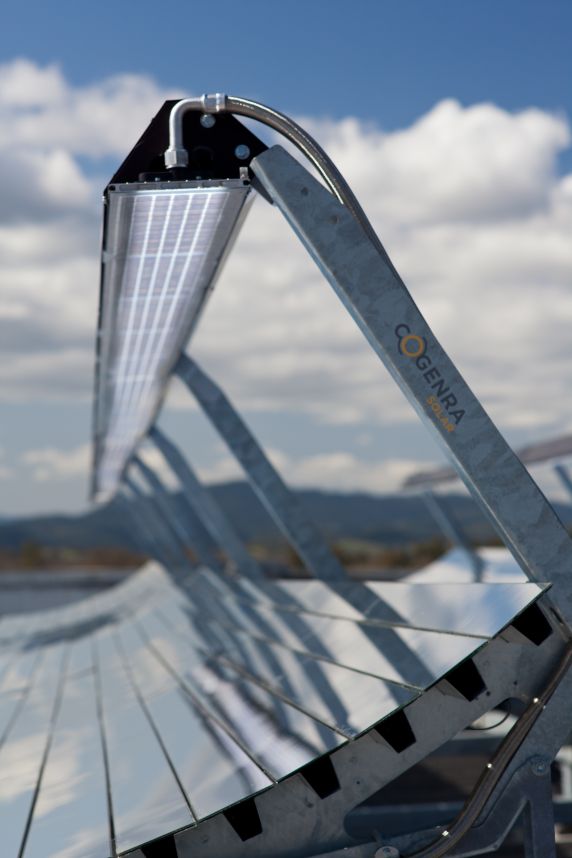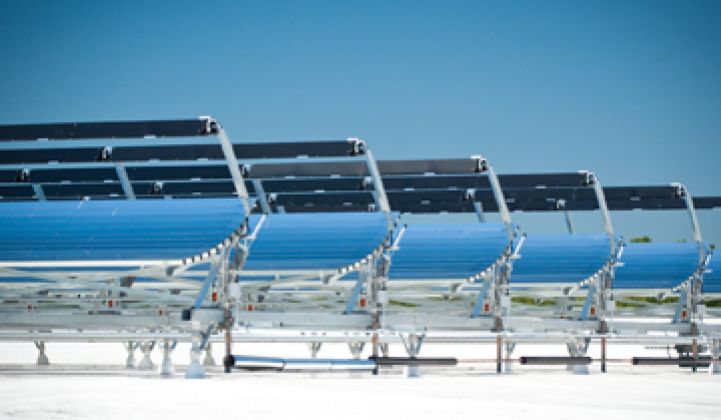We've reported on Cogenra a few times in the past -- upon the company's unstealthing in 2010 and for its first customer announcements. Cogenra is a distributed solar cogeneration company that combines photovoltaic (PV) electricity production and heat collection to deliver electricity and hot water for commercial, industrial and institutional applications.
The firm uses mirrors and single-axis trackers to focus light on a photovoltaic cell assembly. Heat normally lost in a typical PV-only product is used to heat water that actively cools the solar cells. Cooler solar cells mean better electrical energy harvest while the hot water is used for heating or process water. It's a turnkey system meant to be easily assembled on rooftops or on the ground.
We reported on the firm as it explored ground-mounted usage at the Sonoma Wine Company and when the firm installed a 75-kilowatt solar cogeneration project at General Hydroponics, a Santa Rosa, California-based manufacturer of indoor agricultural systems and nutrients. The Hydroponics project was installed by Cogenra partner Sun Light & Power, with a construction period that spanned less than three weeks.
But the company is now ramping up and adding more customers and repeat business.
While the solar photovoltaic manufacturing industry is in the midst of a global shakeout where it's all about cost per watt and module efficiency, Cogenra operates in a different realm. Although the firm's electricity-hot water hybrid cogeneration equipment has a PV element, the dollar-per-watt metric is somewhat less applicable. The metric used by Cogenra is gallons of hot water per day. Electricity produced by the tracking low-concentration assembly improves payback time and spins the meter backward in net metering situations.
One important metric to consider is that the 30-employee firm has landed 30 projects in five countries in the last nine months, including Facebook and two military installations. Company literature indicates that the firm has deployed more than four megawatts of combined electrical and thermal production.
Cogenra doesn't go head-to-head with solar panel makers but like most renewables, it does compete with natural gas. And these days, natural gas in the U.S. is cheap -- CEO Gilad Almogy says that natural gas in the U.S. equates to a cost of roughly $0.02 to $0.03 per kilowatt-hour. With natural gas relatively expensive in Japan and Europe, Cogenra is focusing on those markets as well as the U.S.
The CEO sees the firm as being in ramp-up mode and working with customers for repeat orders for this very site-specific installation. Customers with demand for hot water include the food and beverage industry and people-intensive sites such as schools, hospitals, or Army bases.
Almogy said, "When we install, we look at the customer usage over 24 hours and design the system to deliver hot water when they need it." That includes thermal storage.
The firm targets commercial applications, not residential, as well as "off-gas-grid" applications where the Cogenra system becomes economical to use without subsidies. The heat can also be used for cooling applications, and the food and beverage companies, as well as data centers, universities, office buildings tend to have large "chilling loads," as well. The firm's first chiller installation is coming soon, according to the company.
The Cogenra system produces water at 70˚C, requires no special permitting or roof modifications to support the additional load, and comes complete with integrated hydronics, controls, and inverter. Cogenra monitors every installation remotely.
Cogenra’s system is SRCC- (Solar Rating and Certification Corporation) and IEC- (International Electrotechnical Commission) certified for both thermal and electric rebates, including the California Solar Initiative (CSI), which offers an incentive for solar hot water systems. CSI thermal rebates, currently offered in the first-tier level of $12.82 per therm of year one displaced gas, complement the CSI photovoltaic rebates, resulting in faster paybacks than traditional solar hot water or solar electric systems alone. The installations are also eligible for the 30 percent Investment Tax Credit.
With the CSI and federal rebates, a Cogenra customer could yield a return on their investment in less than five years, while hedging against future utility price hikes and gas price volatility, according to a Cogenra case study.
Cogenra claims that its system produces five times more energy and three times the greenhouse gas reductions of traditional solar offerings.
About 190 gigawatts of solar water heating is installed globally, according to Almogy, the CEO. Compare that to the 50 gigawatts of solar photovoltaics installed on the ground.
"But solar water heating is five times more efficient than PV," according to the CEO, and therefore has a much faster payback. It's also an accepted way of doing things in China, the Mideast, Germany, and in Austria, according to Almogy. The math shows that solar heat is cheaper than solar electricity, so the much higher efficiency of solar water heating by itself translates to only a minor commercial advantage over PV. Cogeneration, however, takes the best of both worlds by generating as much electricity as standard PV and adding four times as much heat -- the extra four units of solar heat is monetarily equivalent to the solar-produced electricity. It essentially doubles the value of a PV system.
CEO Gilad Almogy was formerly with Applied Materials, and Ratson Morad, the COO, was a member of Solyndra's founding team. Cogenra's board of directors includes Pierre Lamond and Dan Maydan, both Silicon Valley heavy-hitters.
Hybrid PV and hot water is not entirely new -- one of the twists from the Khosla Ventures-funded Cogenra might be the Heat and Power Purchase Agreement (HPPA). This is akin to what SolarCity and SunRun offer in residential solar PV and to what a host of firms like Tioga Energy or Borrego Solar offer for commercial solar. Skyline Innovations and Metrus Energy do hot water and "everything but PV" PPAs.
Venture capitalists with whom I've spoken understand the value of hot water production. They have, however, expressed some distaste for the plumbing aspect of hot water generation, challenging me to name a plumbing startup that went public or garnered VC returns through an acquisition.
The firm compares itself to CPV companies and claims it has more customer sites than most CPV firms such as SolFocus, Amonix, and Skyline Solar.
Other players in the hybrid PV and hot water or solar cooling market include ZenithSolar, with a HCPV/solar hot water system that it claims will produce over 2 kilowatts of electricity and the equivalent of 5 kilowatts of solar hot water, as well as Absolicon, Chromasun, Echo First, Sundrum, Turkey's Solimpeks, and Thrive Power. Pure-play LCPV vendors include Skyline Solar and SunPower's C7 tracker product.





